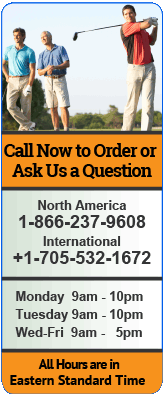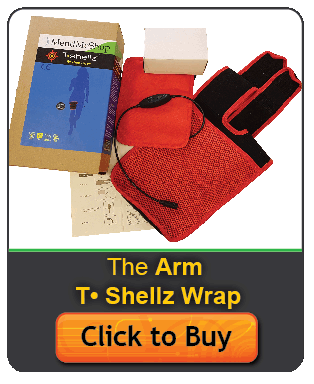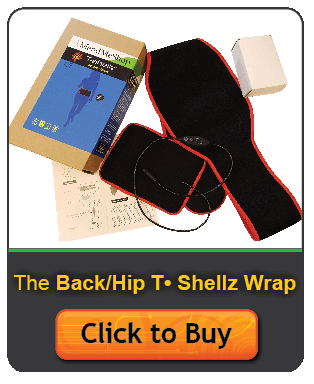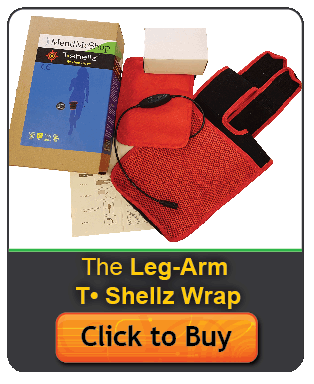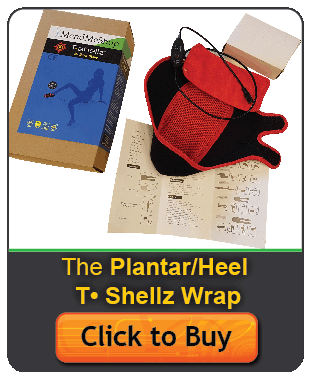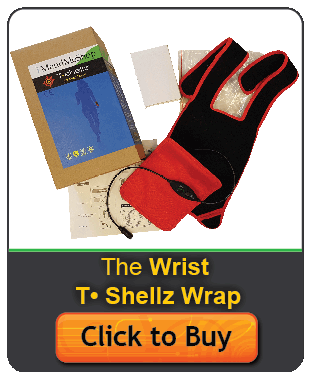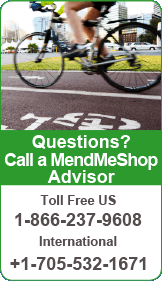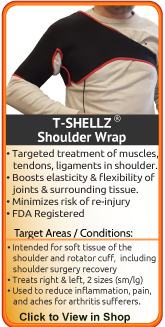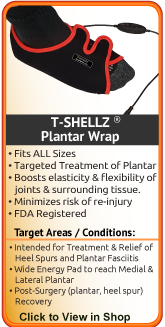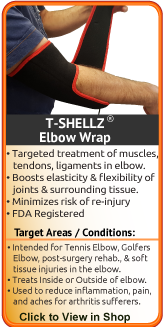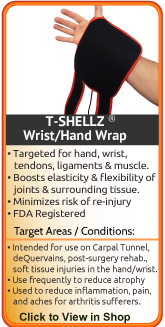Biceps Muscle Strain
The biceps brachii muscle (comprised of the biceps long and short head muscle) are located at the front of your arm. The biceps muscle helps you bend your elbow, rotate your arm and bring your arm straight up in front of you. The biceps tendons and muscles help keep your shoulder stable and also help keep your arm centered in your shoulder socket.
The long head biceps tendon attaches to the top of the shoulder socket (glenoid) while the short head of the biceps tendon attaches to a bump on the shoulder blade called the coracoid process. On the other end of the biceps muscle, the tendon attaches to the radius bone at the elbow.
Causes of Biceps Muscle Strain
Bicep muscle strain is caused by over-stretching or over-loading the muscle tissue in the arm. When the muscle tissue is put under too much stress the muscle fibres become damaged and tear. if there is significant bicep muscle (ie. partial tear), the conversation will usually include bicep tendons, as they are usually damaged as well.
Aside from this, a biceps muscle strain can also be caused by:
- a direct hit to the arm
- Repetitive actions that are common in some sports.
Sports with high risk of biceps damage involve activities such as throwing a ball, swinging a racket, swimming and/or weightlifting.
- Repetitive actions found in some types of work or daily activity. Examples of this would be picking up an overloaded shopping bag or swinging a hammer/sledgehammer.
- natural degenerative changes to muscle fibers due to aging.
- weekend warrior types - those who lead a fairly inactive lifestyle but undergo stressful activities on some ocassions.
Statistically speaking, men have been at higher risk for strains of the biceps muscle and tendon than women.
Symptoms of Biceps Muscle Strain
If you are suffering biceps muscle strain your pain levels may vary depending on how mild to how severe the damage is to the muscle itself. Location of pain may be at the front of the shoulder, the middle, or at the insertion point (down below the elbow). You will probably experience an increase in pain when bringing your arm up in front of you - at shoulder level. Activities such as throwing or working overhead make your pain worse. Small blood vessels may also be damaged which can cause bruising and swelling at the point of the injury site. You may have heard a slight pop and or felt a sensation in the arm or shoulder. Left untreated, a simple biceps muscle strain can worsen and lead to tearing and/or biceps tendon straining, tearing and even detachment.
Biceps Muscle Strain Diagnosis
Biceps Tendonitis is caused by overuse of the shoulder, arm and or elbow. The biceps tendons are a strong, cord-like structures that connect the biceps muscle to the bones in the shoulder and elbow.
Proximal Biceps Tendon Damage
This means you are suffering from biceps tendon damage at the shoulder location. Most cases of biceps tendon damage are proximal in nature and nearly always occur at the long head of the biceps tendon.
If you are suffering from a proximal biceps tendon injury, you will have tenderness and weakness in the arm. Pain will probably manifest itself if you raise your arm in a throwing motion, pull on something or turn your arm from palm down to palm up. You may have pain and a deep achyness in the shoulder that moves down the front of the arm and (in some causes) radiates to the hand. Sometimes a snapping sound or sensation can be felt or heard in the shoulder.
Distal Biceps Tendon Damage
This means you are suffering from biceps tendon damage at the elbow location. If you are suffering from a distal biceps tendon injury, you will probably have pain and some swelling in the front of the elbow, weakness in bending the elbow and weakness in twisting the forearm.
Biceps Tendon Rupture
This occurs when one or more of the biceps tendons tear away from the bone and this can happen at the elbow (distal) or at the shoulder (proximal). In cases of tendon rupture, surgery will be required to re-attach the tendon as a tendon will not reattach on its own.
Biceps Muscle Strain - What To Expect for Diagnosis
The only way to really know you are suffering from a biceps strain is to visit your doctor for a physical examination of your arm / shoulder. During a physical examination of your injured arm, your doctor will be looking for weakness, pain in the arm area and swelling.
He/she will look and feel the bones and soft tissue in both your shoulder and arm to evaluate symmetry to recognize any differences. This will identify any abnormalities, such as mild or severe inflammation, bone deformities, atrophied muscles, redness and/or warmth on the skin. If there is suspected tendon detachment at the elbow, the physician will look for gaps - indicating the tendon is not where it is expected.
Sometimes, one set of symptoms can result in multiple diagnoses. An X-ray, CT scan, MRI or visual ultrasound is often needed in order to diagnose if the area is out of alignment or the extent of the soft tissue damage.
It's important to have a proper diagnosis from a doctor or some other medical professional to determine the cause of your symptoms. This way the right treatment can be used to treat the condition and relieve your pain.
Strains and Sprains: What's the Difference?
Sprains and strains are among the most common injuries in sports, professional, amateur athletes and the general public. You are more at risk for the injury if you have a history of sprains and strains, are overweight, and are in poor physical condition.
What is a strain? A strain is an injury that only happens to tendons and muscles.
What is a sprain? A sprain is a stretch and/or tear that only happens to ligaments.
Sprains and strains are categorized according to severity:
- MILD (Grade 1) -
A muscle is stretched in a mild strain, microscopic tears in the muscle fibres. No loss of muscle strength and there is no joint loosening.
- MODERATE (Grade 2) -
A moderate strain partially tears the muscle, producing joint instability, noticeable loss of strength, and some swelling.
- SEVERE (Grade 3) -
A severe strain produces excruciating pain at the moment of injury, as ligaments or muscle tear completely, or separate from the bone. The complete rupture makes the joint nonfunctional.
You should seek medical attention if you suspect that you've ruptured a tendon, ligament or muscle, can't move the affected joint and have numbness in any part of the injured area.
Biceps Muscle Strain Home Treatment General Guidelines
The good news is that most cases of biceps muscle strains will heal with simple home conservative treatments and surgery is often not needed!
When There is Swelling, Use a Cold Compress or Ice Pack on the Injury:
- for 24 to 72 hours after your initial injury or when you first notice pain and swelling in your shoulder/arm/elbow to stop tissue damage, relieve pain, and decrease swelling.
- After exercise, workouts or activity of any kind to reduce risk of worsening your injury.
- Before and after surgery during rehabilitation to control pre and post-surgery pain and swelling.
- Anytime you feel your shoulder/arm has been over-extended, over-worked, twisted, strained or sprained causing pain and swelling.
- Anytime you have swelling, sharp throbbing pain or inflammation in the tendons or muscles in your arm, elbow or shoulder.
- Any other situation where you need to draw the pain and inflammation out of the area.
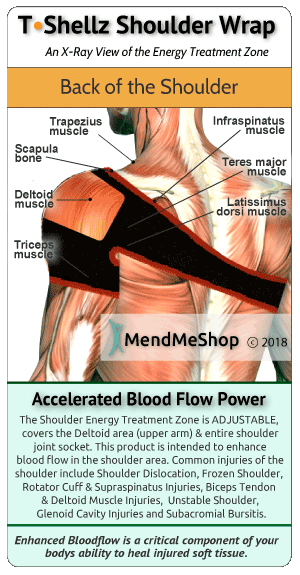 An injury that often leads to straining in other areas (as is the case with a biceps muscle strain) will make an overall recovery hard to initiate. People tend to "chase the pain", meaning they only focus on treating an area that is actively painful, while not taking into account the fact that other areas of the body will be overcompensating...eventually leading to issues in those areas as well. With injuries such as these, the importance of recovering quickly is often underestimated.
We know that heat increases blood flow in soft tissue in the treatment area. This means ligaments, muscles, and tendons. Increased blood flow, combined with heat results in relaxation of the vessel walls. The vessels then gently expand, allowing for more nutrient rich blood flow along with extra oxygen to reach the damaged tissues. Plus, the enhanced blood flow helps in flushing waste and fluid build-up from the injury site - further enhancing the ability of the body to heal.
Now that the importance of localized enhanced blood flow has been established, we should talk about the TShellz Wrap®.
The TShellz Wrap® - Healthy Muscles For The Long Term
The best option we came across in our research to accomplish effective blood flow to soft tissue in the treatment area at home is the TShellz Wrap®. Use of this device results in an increase of blood flow within the treatment area - all in a non-invasive manner.
With a TShellz Wrap® application, more blood begins to flow effectively to tissue in the area - for the length of the treatment and a short duration thereafter. Deep tissue needs the extra blood flow to heal as it is through the blood the body carries the oxygen and nutrients needed for proper and long-term healing.
Have you seen what happens when you add water to a flower wilted from drought? In essence, your injured elbow is much like a "wilted" flower; your body wants to heal its injury, but needs lots of nutrients to do it. Blood brings life to your tissue by delivering healing nutrients and oxygen that are vital for their growth and survival. In addition, the blood carries away toxins and waste cleaning the area and healing it faster. Without a good supply of blood, your elbow simply won't heal properly.
Using a TShellz Wrap® will not expose you to the risk of causing further harm to soft tissue like you can when using rigorous exercise. The Elbow TShellz Wrap® accomplishes the goal of enhanced blood flow without the need for intensive exercise and as such reduces your risk of re-injury.
Who Should Use the Shoulder TShellz Wrap®
We recommend the use of a TShellz Wrap®:
- If you have injured tendons, muscle or other injured tissue in your shoulder or in the biceps muscle/tendon at the shoulder, then the Shoulder TShellz Wrap® will provide the all-important function of boosting blood circulation where it is needed most. As a bonus, this wrap can cover any area on either shoulder.
- If you are dealing with conditions affecting your range of motion in the shoulder.
- If you have a chronic soft tissue shoulder condition that has lasted for years- this device is intended to kick start the recovery process and help strengthen the surrounding and supporting tissues.
- If you are still working with an injured shoulder or bicep, the TShellz Wrap® will help relax injured soft tissue prior to work and after a day at the job.
- If you are still trying to enjoy your favorite activities such as gardening, tennis, golf, etc - use the TShellz Wrap® prior to activity to help reduce chances of re-injuring or re-aggravating those targeted tissues.
- If you are suffering from bursitis in the elbow and want to treat a major source of it (inflammation and damage to tissue surrounding the bursa sac). Through overuse or degenerative changes in the elbow, the muscle and tendons surrounding the bursa sacs will tighten and constrict. When they do, they place pressure on the bursa, causing it to become irritated. Applying a soothing and deep penetrating energy to the area relaxes tissue, taking pressure off the bursa.
- If you have been to a clinic for some form of massage or stretching and your PT or physician has recommended conservative treatments for home.
- If you have injured your shoulder and need surgery, then you will find a blood circulation booster to be a powerful tool after surgery to help surgically repaired tissues rebuild for long-term health. (once the surgery wound has healed and your physician has given the ok)
- If you are experiencing atrophy in your shoulder and upper arm, and want to reduce the chance of re-injury while stretching - we recommend its use every time before you stretch.
Increased Blood Circulation = Increased Healing Capability
TShellz Wraps® contain a unique Carbon Fiber Energy Pad which is flexible and will shape to conform to your body. This Energy Pad emits a uniform wave of perfectly safe energy over its entire surface. This energy is absorbed by soft tissue in the treatment area, opening blood vessels, resulting in an increase in blood flow. Increased blood circulation is what your body needs to accelerate the healing of soft tissue and this is why we recommend the Shoulder TShellz Wrap®.
When To Use a TShellz Wrap®
- After swelling and inflammation have been reduced.
- Before exercise or workouts to warm up muscles and tendons of the biceps to reduce risk of re-injury.
- Before and after surgery during rehabilitation to warm up your tissues before PT exercising or stretching. For Post-Surgery, only use a TShellz Wrap® after the wound has healed, swelling is gone and you have been assigned stretches for home (minimum 6 weeks after surgery).
- Anytime you feel the tendons in your arm/shoulder have stiffened up, are tight and your mobility is reduced causing you more pain.
- Anytime you have sore or aching tissue in your arm, elbow and/or shoulder.
- Any other situation where you need to increase blood flow to your biceps tendonitis injury to relax your tendon, relieve pain, prevent re-injury and enhance flexibility of your tissue.
When Should I Use My TShellz Wrap During the Day?
The most common question we receive from individuals prior to purchasing is - how many times a day should I be using my TShellz Wraps and when should I be using them? While treatment plans will differ for each individual and their specific injury, there are general guidelines that should be adhered to.
- Use a Cold Compress or Ice Pack when you are experiencing inflammation (usually after exertion or movement of the injury area).
The TShellz Wrap® would then be used:
- Right after rising from bed in the morning (as this is when it is most stiff)
- Prior to going to bed at night (to relax the arm & shoulder, allowing for better sleep)
- Before you know you will be using your injured joint (going to work, driving, typing, etc).
Conservative Treatment Tools Our Clients Have Used to Help
Limit Damage & Boost The Body's Soft Tissue Repair Process to the Shoulder at Home:
- A Cold Compress or Ice Pack to reduce inflammation wherever there is pain and/or swelling (as soon as possible).
- A Shoulder TShellz Wrap® to increase blood-flow to the shoulder area (a Localized Enhanced Circulatory Response® Treatment).
- MendMeShop Arnica Pain Cream for temporary relief of pain due to sore muscles and joints.
- A highly adjustable Shoulder Support Brace to provide comfort, support and protection from further injury.
- A High Quality Back Pillow if you are experiencing discomfort while sitting
- An Exercise & Stretching Plan to prevent muscle atrophy and shortened tendons in the shoulder joint. A proper plan will increase elasticity and strengthen the muscles and tendons in the wrist, forearm, elbow, upper arm and shoulder.
Conservative treatment tools just like these have been used successfully by thousands of tendon injury sufferers - just like you.
TShellz Wrap® = Enhanced Blood Flow in the Treatment Area
We believe the use of TShellz Wraps® for boosting blood flow to soft tissue in the area of application is one of the most under-utilized home treatment options available on the market today. We have client after client that have tried many options out there and have been amazed at how effective and fast our recommended treatment tools can provide comfort, relieve pain and increase blood flow in the shoulder and upper arm.
With regular use of the Shoulder TShellz Wrap:
- Your pain will be reduced*.
- Due to increased blood flow, soft tissue in the treatment area on the shoulder will be expected to recover at an accelerated rate with reduced potential for re-injury*.
- Tissue in the treated area should experience a larger range of motion and increased extensibility of collagen tissue* due to the heat effect on soft tissue. This should translate into a reduced rate of re-injury occurrence as soft tissue is known to lengthen and become more flexible when exposed to warm temperature. (*Chapter 9 of "Therapeutic Heat and Cold", 4th edition.
(amazon.com link - Ed. Justus F. Lehmann, M.D., Williams, and Wilkin)
We strongly believe that we can help you, and we have thousands of happy clients to back this claim. You are welcome to try our products for a 60 day period.. If you are committed to following the treatments outlined in the product instructions we are very confident that our TShellz Wraps will aid you immensely. If you do not receive the benefits that countless of our other customers have experienced from our products, call us, mail the product back to us and we will provide you with a full product refund.

Our online shop accepts Visa & Mastercard as well as a Paypal Payment option.
We also encourage your to Call Our Office at 1-866-237-9608 (toll free continental NA) where we can answer any questions you have and/or take your order via phone.
Product specialists are available 9:00 am to 5:00 pm Eastern Standard Time Monday to Friday. If any question or concern arises, call us or simply send us an email at any time (we check our emails constantly all throughout the day and night.. even on holidays!). We will respond as soon as possible. North America Toll Free 1-866-237-9608
Outside North America +1-705-532-1671
Learn More About Muscle Injuries & TreatmentsI want to learn more about Post-Surgery Recovery I want to learn more about muscle injury home treatment using the TShellz Wrap® I want to learn more about Ice & Heat: Which Is Better For Muscle Strains/Spasms? Do I Need Muscle Surgery?
FREE SHIPPING ON ALL PRODUCTS CURRENTLY ENABLED
During your recovery, you will probably have to modify and/or eliminate any activities that cause pain or discomfort at the location of your soft tissue injury until the pain and inflammation settle. Always consult your doctor and/or Physical Therapist before using any of our outstanding products, to make sure they are right for you and your condition. The more diligent you are with your treatment and rehabilitation, the faster you will see successful results!
| 
